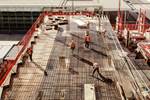ACI publishes code requirements for GFRP rebar
New comprehensive building code requirement covers the use of nonmetallic, GFRP reinforcing bars in structural concrete applications that are covered by ACI 318-19.
The American Concrete Institute (ACI, Farmington Hills, Mich., U.S.), through the work of ACI Committee 440, has released ACI CODE-440.11-22: Building Code Requirements for Structural Concrete Reinforced with Glass Fiber-Reinforced Polymer (GFRP) Bars. The code was developed by an ANSI-approved consensus process and addresses structural systems, members and connections, including cast-in-place, precast, non-prestressed and composite construction.
This is reported to be the first comprehensive building code covering the use of nonmetallic, GFRP reinforcing bars in structural concrete applications. GFRP reinforcement has been in use for decades as an alternative to steel reinforcement because of its non-corrosive, non-magnetic and lightweight properties. According to ACI, this code represents a milestone for this technology, and mirrors ACI 318-19 with provisions for designing GFRP-reinforced concrete beams, one-way and two-way slabs, columns, walls, connections and foundations. Other model codes and standards can directly reference ACI CODE-440.11-22 to enable widespread, responsible use of this important technology.
“What really sets this code apart is that it is dependent on ACI 318-19,” Will Gold, past chair, ACI Committee 440, says. “With this new code, almost almost any structural element covered by ACI 318 can be designed using GFRP reinforcement instead of steel reinforcement. A great deal of new research and validation was required for the code to address elements such as connections and columns. The hard work and efforts of many ACI Committee 440 members made development of this new code possible, and it represents a tremendous accomplishment by the committee.”
ACI Committee 440’s mission is to develop and report information on fiber-reinforced polymers (FRP) for internal and external reinforcement of concrete. Committee 440 has written and maintains a number of design guides, materials and construction specifications, reports and technical notes on the use of FRP in structural concrete applications.
Related Content
-
Running shoe insoles get a lift with thermoplastic fiberglass tapes
FlexSpring insoles take advantage of unidirectional, continuous fiberglass and thermoplastics to enable next-level performance for the everyday runner.
-
Automotive chassis components lighten up with composites
Composite and hybrid components reduce mass, increase functionality on electric and conventional passenger vehicles.
-
Robotized system makes overmolding mobile, flexible
Anybrid’s ROBIN demonstrates inline/offline functionalization of profiles, 3D-printed panels and bio-based materials for more efficient, sustainable composite parts.












.jpg;maxWidth=300;quality=90)

